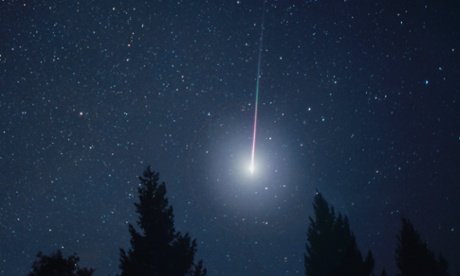The 2013 Leonid meteor shower will be at its best Saturday (November 16) night, and NASA will have a live webcast of the celestial fireworks.
The annual Leonid meteor shower is made of debris from the Comet Tempel-Tuttle, and peaks every year in November.
It is typically one of the most dependable meteor displays of the year. Astronomers at NASA’s Marshall Space Flight Center will provide a live views of the night sky over Huntsville, Ala., beginning at nightfall.
This year, the bright moon may interfere with the meteor display, scientists say.
“Unfortunately the full moon in the sky will likely wash out all but the very brightest Leonids,” NASA officials explained in a skywatching guide.
“Meteor rates, normally 10-20 per hour, are predicted to be less than 10 per hour. The shower should be visible from any populated area on the planet with clear dark skies, though Northern Hemisphere observers are favored due to the radiant’s location in the constellation Leo.”
The Leonid meteor shower doesn’t require a telescope to view, though a dark sky without city lights will make for better viewing.

“For optimal viewing, find an open sky because Leonid meteors can appear in any part of it,” NASA added in a statement.
“Lie on the ground and look straight up into the dark sky. Again, it is important to be far away from artificial lights. Your eyes can take up to 30 minutes to adjust to the darkness, so allow plenty of time for your eyes to dark-adapt.”
NASA’s webcast is one of two online Leonid viewing events this weekend. On Sunday, the online community telescope Slooh will host a webcast double feature to stream live views of the Leonids and the potentially dazzling Comet ISON, which is now visible in the pre-dawn sky to the unaided eye.
The Slooh Leonid webcast will begin Sunday night at 8 p.m. EST and last 45 minutes. The Comet ISON webcast will begin at 9 p.m. EST. You can also watch both webcasts via Slooh’s iPad app and at the website Slooh.com.
The Leonid meteor shower, which is made of rocky bits of debris from the Comet Tempel-Tuttle, peaks every year in November. The icy comet is circling the sun and is slowly being melted by the sun’s heat. It reaches the solar system once every 33 years and its long, slow disintegration has left a rocky trail millions of miles wide and hundreds of millions of miles long.
“We can predict when Earth will cross a debris stream with pretty good accuracy,” NASA astronomer Bill Cooke said in a statement.
“The intensity of the display is less certain, though, because we don’t know how much debris is in each stream.”
Some of that rocky trail drifts into Earth’s orbit every November. When the comet debris collides with Earth’s atmosphere, about 50 miles to 80 miles above the planet, the rocks are vaporized in a flash and fireballs seem to be exploding out of the constellation Leo, leaving bluish white, glowing trails in their wake.
Every 33 years, the Leonid shower is truly breathtaking, with more than 1,000 meteors lighting up the sky per hour, NASA officials said. Unfortunately, that display won’t happen again until 2034, they added.
[youtube xi6ErKFClxc 650]
